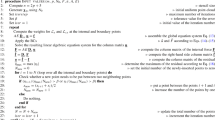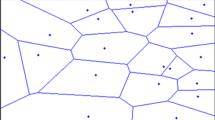Abstract
The mesh-free interpolation method-based recovery of finite element discretization error is presented in this study. Two interpolation schemes, namely radial point interpolation method and moving least squares method, are taken for the recovery of finite element solution error. The global and elemental errors of finite element solution are evaluated in energy norm. The two-dimensional benchmark elastic problems are analysed using triangular/quadrilateral meshing schemes to prove the proposed mesh-free error estimation techniques validity and the effectiveness. The results of the mesh-less interpolation recovery-based error estimation are also compared with mesh-dependent least squares interpolation method-based error estimation. The mesh-free recovery is based on the fitting of a higher-order polynomial to the field variable over a mesh-less patch (radial support domain) using RPI and MLS interpolation method, while the mesh-dependent recovery is based on recovery of the field variable over a patch of nodes surrounding the particular given node using RPI, MLS and LS interpolation method. The study presents the effect of polynomial basis function (LS), polynomial basis function along with radial basis function (RPI)-based interpolation method and weighted polynomial basis function (MLS) on the recovery of finite element solution error. The quality of error estimation under different interpolation schemes is compared in terms of convergence characteristics, local/global effectivity, error distribution patterns and adaptively refined meshes. It can be concluded that weighting function of least squares interpolation affects considerably the mesh-free error estimation.














Similar content being viewed by others
References
Babuska, I.; Banerjee, U.; Kergrene, K.: Strongly stable generalized finite element method: application to interface problems. Comput. Methods Appl. Mech. Eng. 327, 58–92 (2017)
Dekker, R.; van der Meer, F.P.; Maljaars, J.; Sluys, L.J.: A cohesive XFEM model for simulating fatigue crack growth under mixed-mode loading and overloading. Int. J. Numer. Methods Eng. (2019). https://doi.org/10.1002/nme.6026
Yagawa, G.: Node by node parallel finite elements: a virtually meshless method. Int. J. Numer. Methods Eng. (2004). https://doi.org/10.1002/nme.955
Lee, C.-K.; Mihai, L.A.; Hale, J.S.; Kerfriden, P.; Bordas, S.P.A.: Strain smoothing for compressible and nearly-incompressible finite elasticity. Comput. Struct. (2017). https://doi.org/10.1016/j.compstruc.2016.05.004
Chen, G.: A view on manifold method comparing with finite element method. Comput. Mech. (2007). https://doi.org/10.1007/978-3-540-75999-7_188
Sapozhnikov, S.B.; Shchurova, E.I.: Voxel and finite element analysis models for ballistic impact on ceramic-polymer composite panels. Proc. Eng. (2017). https://doi.org/10.1016/j.proeng.2017.10.457
Terada, K.; Ishii, T.; Kyoya, T.; Kishino, Y.: Finite cover method for progressive failure with cohesive zone fracture in heterogeneous solids and structures. Comput. Mech. (2007). https://doi.org/10.1007/s00466-005-0017-6
Osaki, H.; Matsubara, H.; Yagawa, G.: 3D Crack propagation analysis using free mesh method. Comput. Methods Eng. Sci. (2006). https://doi.org/10.1007/978-3-540-48260-4_47
Ye, T.; Pan, D.; Huang, C.; Liu, M.: Smoothed Particle Hydrodynamics (SPH) for complex fluid flows: recent developments in methodology and applications. Phys. Fluids 31, 011301 (2019). https://doi.org/10.1063/1.5068697
Breitkopf, P.; Rassineux, A.; Savignat, J.-M.; Villon, P.: Integration constraint in diffuse element method. Comput. Methods Appl. Mech. Eng. (2004). https://doi.org/10.1016/j.cma.2003.12.014
Lin, Z.; Liu, F.; Wang, D.; Gu, Y.: Reproducing kernel particle method for two-dimensional time-space fractional diffusion equations in irregular domains. Eng. Anal. Bound. Elem. (2018). https://doi.org/10.1016/j.enganabound.2018.10.002
Xiang, H.; Chen, B.: A moving particle semi-implicit method for free surface flow: improvement in inter-particle force stabilization and consistency restoring. Numer. Methods Fluid (2017). https://doi.org/10.1002/fld.4354
Mužík, J.; Sitányiová, D.: Application of the Meshless Local Petrov–Galerkin method for subsoil settlement analysis. Adv. Mater. Res. (2014). https://doi.org/10.4028/www.scientific.net/AMR.969.55
Liu, M.B.; Xie, W.P.; Liu, G.R.: Modelling incompressible flows using a finite particle method. Appl. Math. Modell. (2005). https://doi.org/10.1016/j.apm.2005.05.003
Chen, J.-S.; Hillman, M.M.; Chi, S.-W.: Mesh free Methods: progress made after 20 Years. J. Eng. Mech. 143(4), 1–38 (2017)
Belytschko, T.; Lu, Y.Y.; Gu, L.: Element-Free Galerkin method. Int. J. Numer. Methods Eng. 37, 229–250 (1994)
Liu, G.R.; Gu, Y.T.: A local radial point interpolation method (LR-PIM) for free vibration analyses of 2-D solids. J. Sound Vib. 246(1), 29–46 (2001)
Lancaster, P.; Salkauskas, K.: Surfaces generated by moving least squares methods. Math. Comput. 87, 141–158 (1981)
Iqbal, M.; Gimperlein, H.; Mohamed, M.S.; Laghrouche, O.: An a posteriori error estimate for the generalized finite element method for transient heat diffusion problems. Int. J. Numer. Methods Eng. (2017). https://doi.org/10.1002/nme.5440
Ahmed, M.; Singh, D.; Desmukh, M.N.: Element Free Galerkin post-processing technique based error estimator for elasticity problems. Civ. Eng. J. (2018). https://doi.org/10.28991/cej-03091211
Zienkiewicz, O.C.; Zhu, J.Z.: The Super-convergent patch recovery and a posteriori error estimates, Part I, the error recovery technique. Int. J. Numer. Methods Eng. (1992). https://doi.org/10.1002/nme.1620330702
Ubertini, F.: Patch recovery based on complementary energy. Int. J. Numer. Methods Eng. (2004). https://doi.org/10.1002/nme.924
Ahmed, M.; Singh, D.; Islam, S.: Effect of contact conditions on adaptive finite element simulation of sheet forming operations. Eur. J. Comput. Mech. (2015). https://doi.org/10.1080/17797179.2015.1012632
Mohite, P.M.; Upadhyay, C.S.: Adaptive finite element based shape optimization in laminated composite plates. Comput. Struct. (2015). https://doi.org/10.1016/j.compstruc.2015.02.020
Rajendran, S.; Liew, K.M.: Optimal stress sampling points of plane triangular elements for patch recovery of nodal stresses. Int. J. Numer. Methods Eng. (2003). https://doi.org/10.1002/nme.790
Zhang, R.; Li, L.; Zhao, L.; Tang, G.: An adaptive remeshing procedure for discontinuous finite element limit analysis. Int J. Numer. Methods Eng. (2018). https://doi.org/10.1002/nme.5925
Duflot, M.; Bordas, S.: A posteriori error estimation for extended finite elements by an extended global recovery. Int. J. Numer. Methods Eng. (2008). https://doi.org/10.1002/nme.2332
Calik-Karaköse, Ü.H.; Askes, H.: A recovery-type a posteriori error estimator for gradient elasticity. Comput. Struct. (2015). https://doi.org/10.1016/j.compstruc.2015.04.003
Ahmed, M.; Singh, D.; Desmukh, M.N.: Interpolation type stress recovery technique based error estimator for elasticity problems. Mechanics (2018). https://doi.org/10.5755/j01.mech.24.5.19937
Cao, Y.; Yao, L.; Yin, Y.: New treatment of essential boundary conditions in EFG method by coupling with RPIM. Acta Mech. Solida Sin. (2013). https://doi.org/10.1016/S08949166(13)6002
Mirzaei, D.: Analysis of moving least squares approximation revisited. J. Comput. Appl. Maths. (2015). https://doi.org/10.1016/j.cam.2015.01.007
Parret-Fréaud, A.; Rey, V.; Gosselet, P.; Rey, C.: Improved recovery of admissible stress in domain decomposition methods—application to heterogeneous structures and new error bounds for FETI-DP. Int. J. Numer Methods Eng. (2016). https://doi.org/10.1002/nme.5462
Onate, E.; Perazzo, F.; Miquel, J.: A finite point method for elasticity problems. Comput. Struct. 79, 2151–2163 (2001)
Acknowledgements
The author acknowledges the Deanship of Scientific Research for providing administrative and financial supports. The author also acknowledge the Dean, College of Engineering, for his valuable support and help
Funding
Funding for this work has been provided by the Deanship of Scientific Research, King Khalid University, Ministry of Education, Kingdom of Saudi Arabia, under research Grant Award Number 172 (1440).
Author information
Authors and Affiliations
Corresponding author
Rights and permissions
About this article
Cite this article
Ahmed, M. A Comparative Study of Mesh-Free Radial Point Interpolation Method and Moving Least Squares Method-Based Error Estimation in Elastic Finite Element Analysis. Arab J Sci Eng 45, 3541–3557 (2020). https://doi.org/10.1007/s13369-019-04154-5
Received:
Accepted:
Published:
Issue Date:
DOI: https://doi.org/10.1007/s13369-019-04154-5




